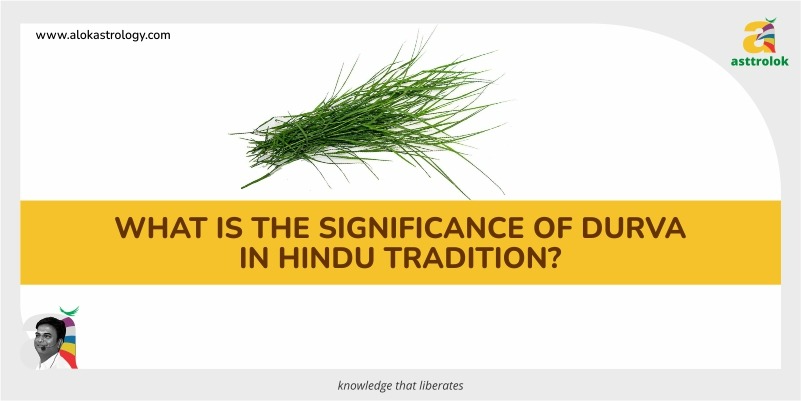A unique variety of sacred grass is called durva (Agrostis linearis). The terms duhu and avam are the origin of the word durva. Duhuavam refers to both what is far away and what draws close. Durva has a better ability to draw in and continually strengthen the attributes of the three gods AadiShiv, AadiShakti, and Aadi Ganesh. Typically, durva’s tender shoots are employed in a deity’s puja rite. The ability of these fragile shoots to absorb divine principles found in the dewdrops that land on their leaves is greatest. The worshipper gains from this. Durvas (Significance of Durva) are not utilised in puja rituals if they bear flowers. The presence of flowers indicates ripeness. The plant’s vitality decreases as it ripens. This further lessens its ability to draw in divine fundamental frequencies.
Know more about the Importance of Durva in Hindu Mythology. Get an online astrology consultation by the world-renowned Astrologer Mr. Alok Khandelwal.
Durva & Lord Ganesha:
Once upon a time, Analasura was an Asura (devil). His voice caused the earth to quiver, and his eyes once burned with fire. As a result, everyone was terrified of him. Even the Gods shook with dread. Therefore, all of the gods turned to Ganesha to save them from Analasura’s grasp. Ganesha transformed into a child and promised the Gods that Analasura would not harm them. “Sarvkasha” war was launched by Ganesha. The strong eyes of Analasura shoot out fireballs and obliterate Ganesha’s surroundings. Finally, Analasura attempted to swallow Ganesha, but Ganesha displayed his “Virat” roop and swallowed Analasura to kill it. However, due to increasing body heat, Ganesha was unable to even lie down. He was agitated. Despite the excruciating heat from the body, he smeared sandal paste all over it.
Ganesha is also referred to as “Bhalachandra” since all the gods at this time decided to build the moon’s foundation on his head. Because Lord Vishnu lent his lotus, Ganesha is sometimes referred to as “Padmapani.” Ganesha’s hip was bound with a cobra that Lord Shankara had plucked from his neck. Despite the rains of Lord Varuna, the rain god, the heat did not abate. A miracle occurred thanks to certain sages who arrived there with a group of 21 Durvas and placed them on his head. Ganesha recovered fully. Ganesha said that while many gods attempted to assist, only a plain grass called “Durva” turned my suffering into regular life. With this, he declared that whoever offered me Durva with dedication would be holy and receive Punya.
Second, it is stated that there once was a stunning Apsara who fervently adored and prayed to wed Ganesha. She once appealed to Ganesha as well. However, Apsara was cursed by Parvati, Ganesha’s mother, to take the form of ordinary grass on earth so that no one would notice her. Durva, however, pleaded for forgiveness and requested ushaap. Even if she is in the grass form, Ganesha will adore her, and Parvati forgives her and assured her.
Durvarchan
Give Sri Ganeshji the Durva along with three or five pamphlets. They go by the name durvankur. Durvankur’s three leaflets attract Primal Shiva, Primal Shakti, and Primal Ganesh. There should be at least 21 durvas offered to Sri Ganesh ji. After dipping the Durva in water, tie them together and give them to Sri Ganesh ji. Durva should cover Sri Ganesh ji’s idol except for the face. As a result, the aroma of Durva fills the area around the idol. Each chant of I or utterance of Sri Ganesh ji’s one thousand names is ritually honoured by sacrificing a Durva. This is known as “devachan.” Starting with the holy feet of the Ganesh idol, this offering of Durva is made.
Durvarchan's effects
The Holy Feet of the idol radiate the Principle of the Deity more strongly than other parts of the idol. As a result, the Durva provided at the beginning attracts the Ganesh Principle more strongly. The Durva that is later offered incorporates this Principle. The Durva, which is presented in order, spreads this Principle to the top. As a result, the idol emits a higher proportion of Chaitanya frequencies.
This durvarchan attracts the greater Ganesh Principle to the worship site. The idol attracts the Nirgun vibrations of the Deity Principles. The worshipper benefits more as a result of these frequencies being converted into Sagun vibrations in the Sri Ganesh idol and being released through the idol.
Thus, it is obvious that the negative impact of the raja-tama-predominant Principles on the environment is lessened as a result of the emission of the Deity’s Principle through the Durva. This is the cause of the distress experienced by a person exposed to negative energies when they come into contact with the Durva.
